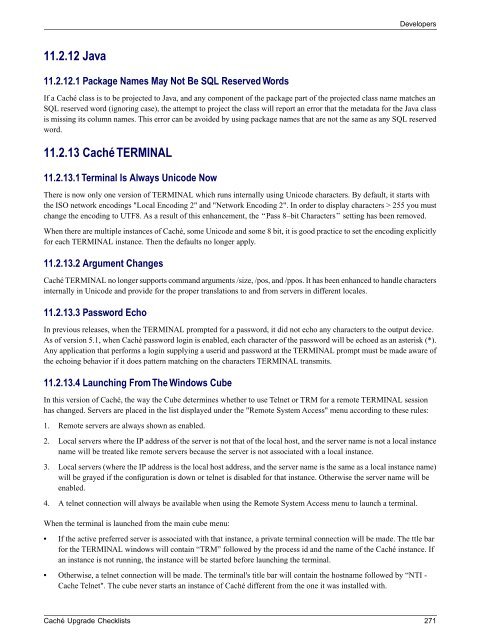Caché Upgrade Checklists - InterSystems Documentation
Caché Upgrade Checklists - InterSystems Documentation
Caché Upgrade Checklists - InterSystems Documentation
You also want an ePaper? Increase the reach of your titles
YUMPU automatically turns print PDFs into web optimized ePapers that Google loves.
Developers11.2.12 Java11.2.12.1 Package Names May Not Be SQL Reserved WordsIf a <strong>Caché</strong> class is to be projected to Java, and any component of the package part of the projected class name matches anSQL reserved word (ignoring case), the attempt to project the class will report an error that the metadata for the Java classis missing its column names. This error can be avoided by using package names that are not the same as any SQL reservedword.11.2.13 <strong>Caché</strong> TERMINAL11.2.13.1 Terminal Is Always Unicode NowThere is now only one version of TERMINAL which runs internally using Unicode characters. By default, it starts withthe ISO network encodings "Local Encoding 2" and "Network Encoding 2". In order to display characters > 255 you mustchange the encoding to UTF8. As a result of this enhancement, the “Pass 8–bit Characters” setting has been removed.When there are multiple instances of <strong>Caché</strong>, some Unicode and some 8 bit, it is good practice to set the encoding explicitlyfor each TERMINAL instance. Then the defaults no longer apply.11.2.13.2 Argument Changes<strong>Caché</strong> TERMINAL no longer supports command arguments /size, /pos, and /ppos. It has been enhanced to handle charactersinternally in Unicode and provide for the proper translations to and from servers in different locales.11.2.13.3 Password EchoIn previous releases, when the TERMINAL prompted for a password, it did not echo any characters to the output device.As of version 5.1, when <strong>Caché</strong> password login is enabled, each character of the password will be echoed as an asterisk (*).Any application that performs a login supplying a userid and password at the TERMINAL prompt must be made aware ofthe echoing behavior if it does pattern matching on the characters TERMINAL transmits.11.2.13.4 Launching From The Windows CubeIn this version of <strong>Caché</strong>, the way the Cube determines whether to use Telnet or TRM for a remote TERMINAL sessionhas changed. Servers are placed in the list displayed under the "Remote System Access" menu according to these rules:1. Remote servers are always shown as enabled.2. Local servers where the IP address of the server is not that of the local host, and the server name is not a local instancename will be treated like remote servers because the server is not associated with a local instance.3. Local servers (where the IP address is the local host address, and the server name is the same as a local instance name)will be grayed if the configuration is down or telnet is disabled for that instance. Otherwise the server name will beenabled.4. A telnet connection will always be available when using the Remote System Access menu to launch a terminal.When the terminal is launched from the main cube menu:• If the active preferred server is associated with that instance, a private terminal connection will be made. The ttle barfor the TERMINAL windows will contain “TRM” followed by the process id and the name of the <strong>Caché</strong> instance. Ifan instance is not running, the instance will be started before launching the terminal.• Otherwise, a telnet connection will be made. The terminal's title bar will contain the hostname followed by “NTI -Cache Telnet". The cube never starts an instance of <strong>Caché</strong> different from the one it was installed with.<strong>Caché</strong> <strong>Upgrade</strong> <strong>Checklists</strong> 271
















